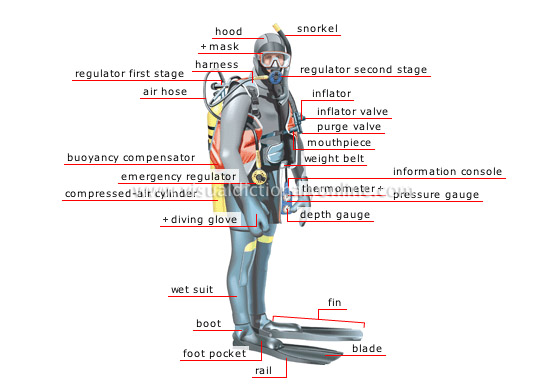











Page created by Heather C. Hopkins
Last updated 11/25/2009
Scuba Diving Equipment can be expensive, but for good reason: it is necessary to keep you alive underwater. Physics has led to many different innovations in scuba equipment, and dive gear is much more advanced today than it was in the past. Here are some examples of how physics is applied to scuba diving gear:

Dive gear illustration, courtesy of Merriam-Webster Online at
http://visual.merriam-webster.com/sports-games/aquatic-nautical-sports/scuba-diving/scuba-diver.php
Scuba tanks: Physics comes in to play in many ways concerning scuba tanks. As seen previously in the pressure section, Boyle's Law shows that gases can be compressed to a smaller volume at an increased pressure. This fact makes scuba tanks possible. Tanks are filled with gas at a higher pressure, and a smaller volume than the gas normally exists. In addition, factors such as tank pressure and volume, the surrounding water temperature, and individual breathing patterns all affect the amount of time a tank can be used on a dive. Also, Charles' Law describes how the volume of a gas changes with the temperature. This explains why filling tanks is done underwater to keep the tanks from heating, since compressing gas increases the heat.
BCDs and weight belts: The main purpose of the BCD(Buoyancy Control Device) and the weight belts are to maintain buoyancy at the diver's desired level. These two pieces of gear are important to minimize harm on aquatic life (especially coral), and to minimize uncontrolled, rapid ascending, which can potentially be dangerous.
Regulators: Regulators are the devices used to breathe underwater by reducing the high pressure in a scuba tank to match surrounding pressure in the water. These devices may also have other features. For instance, some regulators include a heat exchanger, which makes valves resistant to freezing. Another feature of many regulators is the ability to maximize air flow at depth.
Power inflators: These are simple on and off valves. They equalize pressure between a diver's tank and their buoyancy control device (BCD). When there is low pressure in a person's tank, these power inflators still work, but at slower rates.
Diving instruments and dive tables: Diving instruments are essential for reducing the risk of decompression sickness (as described in the dangers section of this website). In addition, dive tables are used to calculate the amount of absorbed nitrogen in the body, and how much can be released safely.
Scuba fins: Fins have various designs, most of which are incorporated into the blade of the fin. For example, some fins have ribs on the blade, which act as vertical stabilizers. Another feature of fins is vents, which reduce resistance to movement and help increase efficiency.
